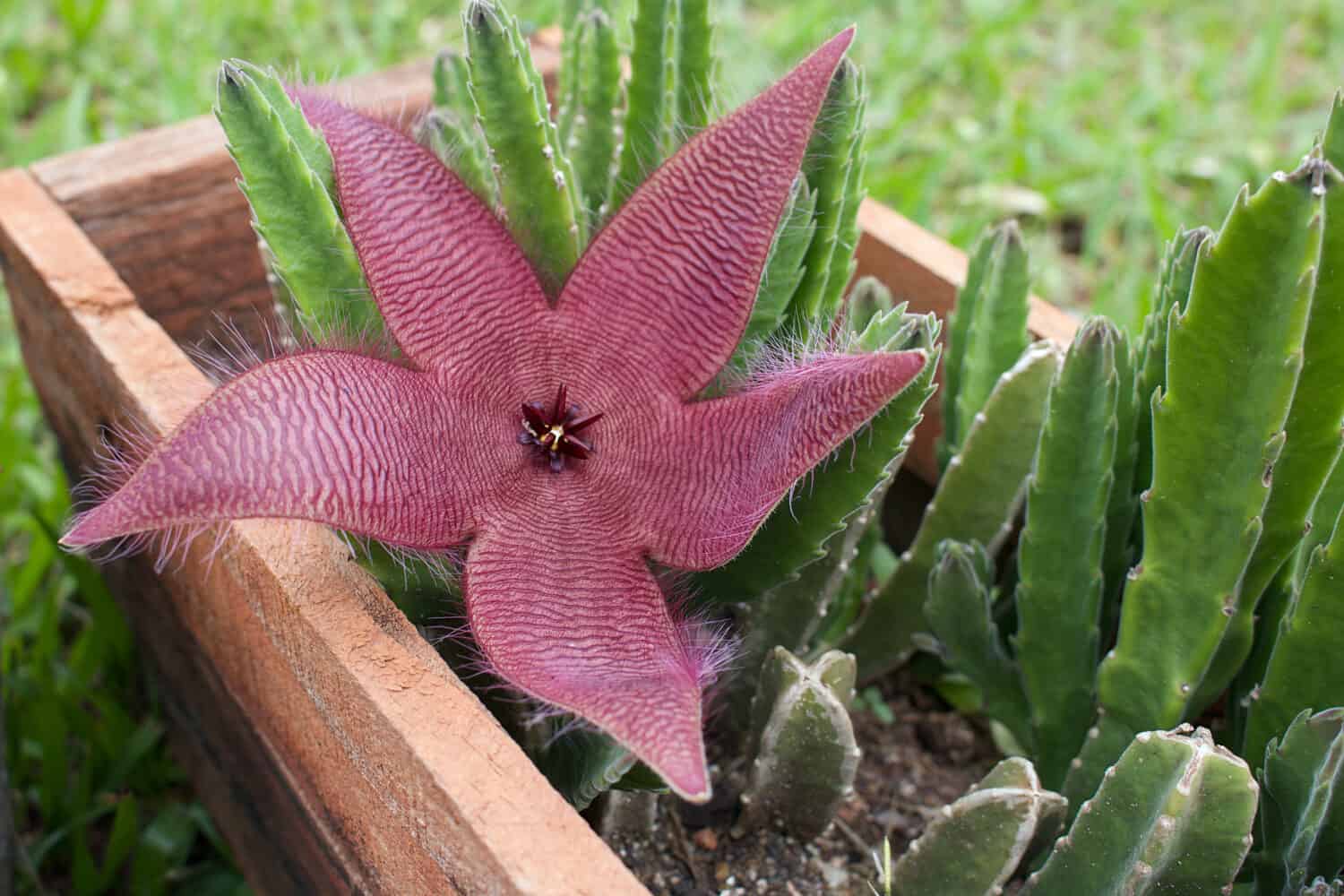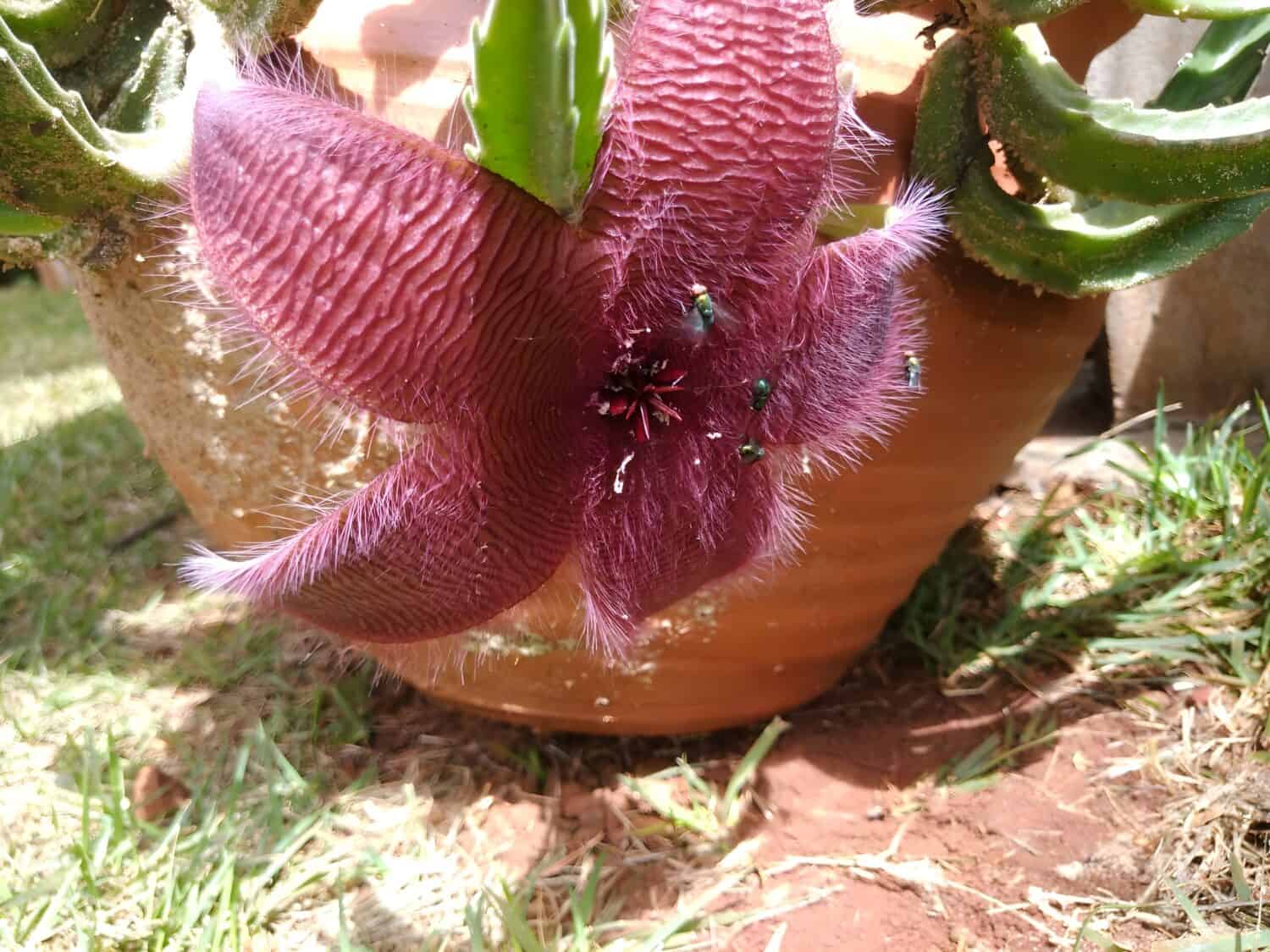The starfish cactus is a very popular houseplant all over the world, and it’s understandable why. This beautiful succulent impressively looks like a starfish! It comes in different colors and produces a large and unique flower with a strong smell. This lovely plant varies in color and size. Despite its complex appearance, the starfish cactus is low-maintenance and a great show-off plant for beginners. Follow along to learn more about starfish succulents and how to properly care for them.
What is a Starfish Cactus?
Technically, there are multiple plants we call starfish cacti. While they are different species, they all belong to the same genus, Stapelia. However, they are also referred to as Orbea variegata, which confuses. These plants are native to South Africa and are known for their large and unique starfish-like flowers. The flowers produce an awful odor of rotting meat, which attracts many insects like flies. Another name for these plants is the carrion plant.
One of the most common starfish cacti is the Stapelia grandiflora. This plant is not a cactus, but a flowering succulent. The plant has many hybrids and comes in different colors and sizes. The stems are bright green and can grow up to 7 inches tall. Stapelia grandiflora flowers are large, and yet smaller than the Stapelia gigantea. Most flowers are pink or purple but vary in color and pattern.
Another species that is also called the starfish cactus is the Stapelia gigantea. This succulent is native to the desert regions of South Africa to Tanzania but is found all over the world as a popular houseplant. This plant grows up to about 8 inches tall and produces large flowers with a 9.8-inch diameter. The flowers are wrinkly and hairy with red and yellow coloration.
The Stapelia hirsuta belongs to the same genus. This plant produces large red flowers that look like rotting meat. The flowers are very hairy. This species is native to South Africa and southern Namibia. Like the others in this article, there are multiple subspecies and hybrids.

Starfish cacti are native to South Africa and vary a lot in color and size.
©Cristina Gurski/Shutterstock.com
Colors of Starfish Cactus
Starfish cacti come in many colors, depending on the species. These plants are also easy to mix, meaning there are many hybrids. However, most starfish cacti are red or purple and resemble rotting meat. This helps attract flies, along with their pungent smell.
While red and purple starfish cacti are more common, there are also brown and beige flowers. Some flowers bloom with unique markings or patterns. For example, a flower can be off-white or yellow with brown speckled spots and a round button-like center. The stems of the plants are bright green.
When Will My Starfish Cactus Bloom
Starfish succulents produce large variable flowers with a distinct smell. Unlike other succulents, this plant doesn’t bloom in spring. These flowers generally bloom in late summer and fall, but the exact months depend on the area. For example, starfish plant flowers bloom from July to September in North America. However, in South Africa, their native range, they bloom from November through March.

Starfish cacti bloom from late summer through fall.
©eliscora/Shutterstock.com
Caring for a Starfish Cactus
Despite their large and stunning appearance, starfish succulents are easy to grow and care for, as long as you provide the right conditions. They aren’t cacti, so you mustn’t treat them like you would treat a cactus. Pruning and trimming are also necessary to keep your plant as healthy as possible. Keep reading to learn more about how to care for this lovely starfish flowered succulent.
Watering
Since starfish cacti aren’t cacti at all, you can’t water it like you would with a spiny cactus. Instead, it requires more frequent watering. Water your starfish succulent well at least once every week or two. The soil needs moisture. Don’t water the plant directly, instead, seep the water into the soil. If you pour water on the plant, the sun can cause harm to its stems.
It’s also necessary you lower the amount of watering slowly leading to winter. For example, you’ll need more water during summer as the sun’s intense rays beat down on your plant. Summer is also when the flowers bloom and the plant uses a lot of energy to grow. During winter though, the plant is dormant and requires less water. Too much water can lead to root rot. Not enough water though, causes the roots to break through the soil looking for moisture. If you notice this, take a bottle and mist the roots. Starfish cacti are strong and resilient plants that can snap back from underwatering quickly.
Sunlight
Bright indirect sunlight works best for this plant. Some people also recommend trapping moisture and increasing humidity and temperature by placing the plant in a glass case. Starfish cacti aren’t picky and can live in cool and warm regions. If you plant this beautiful flowering succulent indoors, ensure it’s by a bright window. If the plant doesn’t receive enough light, the stems lose color and become pale green. Not enough light can also cause the stems to grow long and irregularly.
Nutrition
While you can add fertilizer to your starfish succulent’s soil, it isn’t always necessary. However, if you choose to use a succulent-friendly fertilizer, only use it once a month in small amounts. Don’t fertilize your plant in winter as they are in their dormant period and can suffer from stress and shock. You can also fertilize only once a year in the fall. Sometimes the potting soil has enough organic matter and nutrients, so fertilizer isn’t needed.
Soil-Type
Starfish cacti survive in different climates, temperatures, and soils. You can purchase succulent soil, but it’s cheaper and more effective to create your blend. Mix potting soil with organic materials like pumice or perlite. You can also use little pebbles, sand, coconut coir, or peat moss. It’s also important you choose well-draining soil. If you are growing this lovely flowering plant in a container, choose a pot with large drainage holes.
Pests and Diseases
As tough as this plant looks, it’s susceptible to many diseases and pests. For example, root rot, fungal infections, and aphids are common problems with this plant. Root rot is easy to avoid though as long as you decrease watering and choose a pot with good drainage. Root rot is also easy to spot since the stems develop brown wet spots and the plant produces a moldy smell. Small insects like aphids can cause a lot of damage to the stems. Once you notice a problem, quickly use a natural pesticide solution to get rid of the insects. Some gardeners recommend spraying plants with neem oil or a mixture of vinegar, dish soap, and water to kill aphids.
How to Propagate a Starfish Cactus
You don’t have to run to the garden store or nursery every time you want a new starfish cactus. As soon as you have one, you can take cuttings to propagate the plant. The best part is it’s quick, easy, and free. Cut a 3 to 4-inch stem with a clean knife or pair of scissors and let the end callus. It can take up to a week for the end to fully dry. Try not to expose the cutting to direct sunlight as it can dry out the stem. It’s also best if you remove more than one cutting to increase the chances of the cutting rooting.
Place the cutting in a small container with succulent soil and peat or gravel. Keep the soil moist, without over-watering it, and place the pot in an area with low light. Within a month, the plant should develop roots if successful.
You can also grow this lovely plant from seed. If you allow your plant to fruit, dry the fruit and gather the seeds. Plant the seeds in a pot with soil. Don’t bury the starfish cactus seed. Instead, lightly miss the seed and wrap plastic wrap to trap the moisture. A seedling should emerge within a few weeks in low indirect light near a window.

Starfish cacti are easy to propagate. You can also grow this plant from seed.
©Bilalstock/Shutterstock.com
The photo featured at the top of this post is © G Allen Penton/Shutterstock.com
Thank you for reading! Have some feedback for us? Contact the AZ Animals editorial team.






